|
Family: Felidae (cats)
Life
>
Eukaryotes >
Opisthokonta >
Metazoa (animals) > Bilateria > Deuterostomia >
Chordata > Craniata > Vertebrata (vertebrates) >
Gnathostomata (jawed vertebrates) > Teleostomi (teleost
fish) > Osteichthyes (bony fish) > Class:
Sarcopterygii (lobe-finned fish) > Stegocephalia
(terrestrial vertebrates) > Reptiliomorpha > Amniota >
Synapsida (mammal-like reptiles) > Therapsida > Theriodontia
> Cynodontia > Mammalia (mammals)
> Placentalia (placental mammals) > Laurasiatheria
> Ferungulata > Ferae > Carnivora
Species indigenous to southern Africa
|
Subfamily: Acinonychinae |
|
|
|
Acinonyx jubatus (Cheetah)
Hunts down prey (mainly antelope) by chasing it at high
speed over short distances. Its running speed is such that it holds the
record as the fastest land mammal, being able to run in excess of 70 km/h.
Females hold territories and do all the work in rearing the young. Males are
nomadic.
|
![[photo Callie de Wet ©]](images/195091683s.jpg) |
|
Subfamily: Pantherinae |
|
|
|
Panthera pardus (Leopard)
One of the “Big Five” in Africa, leopards are a
highly popular tourist attraction in national parks and reserves,
which makes them
highly prized and an important source of income. Males are solitary
and females rear the cubs. Prey is varied, ranging from invertebrates
through to medium-sized antelope. Leopards are found in the mountains of the
Western Cape but are rarely seen. |
 |
|
|
Panthera leo (Lion)
One of Africa’s “Big Five”. The largest of the African cats and the most
social member of the cat family living in prides of 3-30 individuals.
Lionesses give birth to their cubs under cover away from the pride and will
only return to the pride when the cubs are 6-8 weeks old. Male lions will
often kill any existing cubs in the pride after they successfully depose the
dominant male or male group. This results in the females being able to
produce this new male's cubs sooner. |
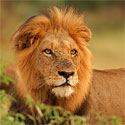 |
|
Subfamily: Felinae |
|
|
|
Caracal caracal
(Caracal)
Caracals occur from Africa through to India and
occupy a wide range of habitats. They are solitary in habit except
when mating or the mother is accompanied by young. Prey includes
mammals up to the size of bushbuck, as well as birds and reptiles.
They are considered vermin by farmers because they attack livestock. |
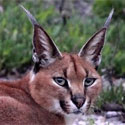 |
|
|
Felis silvestris (African wild cat)
The African wild cat is one of five subspecies of Felis
silvestris, which is a species with a wide distribution through
Africa, Europe, the Middle East and parts of Asia. The species also
includes the Domestic cat, which genetic evidence suggests was
domesticated in the Middle East. African wild cat and domestic cats
often interbreed in the proximity of human habitations and this is
one of the main threats to the survival of the wild subspecies in
its pure form. |
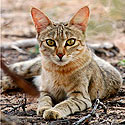 |
|
|
Felis nigripes (Black-footed cat) |
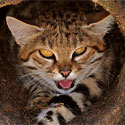 |
|
|
Leptailurus
serval (Serval) |
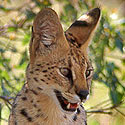 |
|
